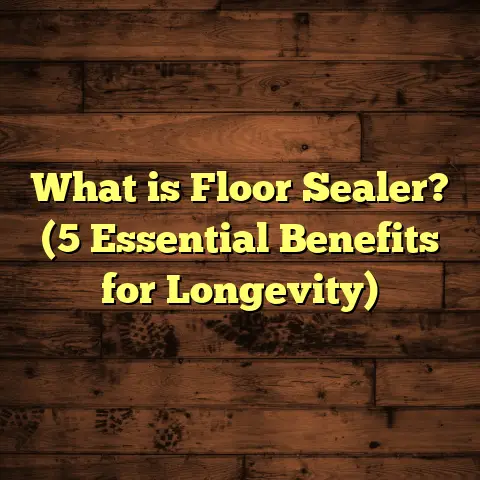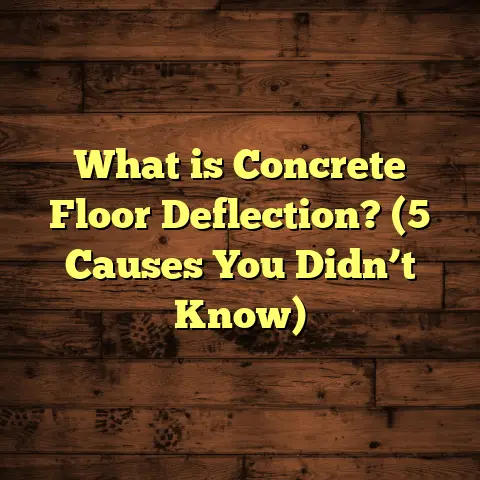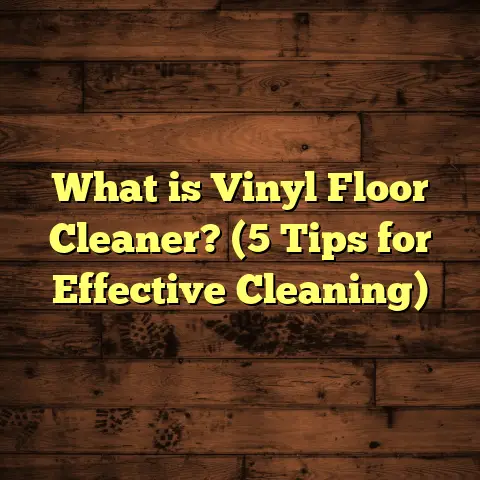What is Wood Floor Varnish? (5 Types for Stunning Finishes)
“A good finish can transform a simple wooden floor into a piece of art that lasts for decades.” – Mark Johnson, Flooring Specialist
I’ve heard this quote many times during my years working with wood floors, and it always rings true. When it comes to preserving and beautifying wood floors, varnish plays a starring role. But what exactly is wood floor varnish? And how do you pick the right type for your project?
What Is Wood Floor Varnish?
Wood floor varnish is a protective coating applied over wooden flooring to enhance both its appearance and durability.
Think about your favorite wooden floor. Maybe it’s in your living room or an old family cabin. That warm glow, the smooth finish beneath your feet, the way the wood grain pops—that’s not just the raw wood itself. It’s the varnish doing its job.
Varnish acts like a shield that protects hardwood from scratches, moisture, stains, and daily wear. But it also makes the wood look richer by deepening the color and enhancing the grain texture. It’s the finishing touch that turns raw hardwood into a lasting feature of your home.
Technically speaking, varnish is made of resins combined with solvents or water. When applied, these ingredients dry or cure to form a hard, transparent film. This film adheres tightly to the wood surface, creating a barrier against damage.
Over my 15 years in flooring, I’ve worked with many people who confuse varnish with stains, oils, or waxes. Here’s a quick breakdown:
- Varnish: Forms a hard protective coat on top of wood.
- Oil finishes: Penetrate into the wood fibers but don’t form a surface film.
- Wax: Adds surface shine but offers minimal protection.
Each of these has its place, but for floors that need durability and beauty, varnish is usually the best choice.
What Makes Wood Floor Varnish Different From Other Finishes?
Why is varnish so popular compared to other kinds of finishes? One reason is its balance of durability and aesthetics.
Oils and waxes can make floors feel softer and more natural but don’t stand up as well to heavy foot traffic or spills. They require frequent reapplication.
Varnish hardens into a solid layer that resists abrasion and water better. Depending on the type, some varnishes can last for years without needing refinishing.
I remember one project where the homeowner had recently applied wax on their hardwood kitchen floor. Within a few months, the floor looked dull and scratched badly because the wax wore off quickly under cooking activity and foot traffic. We ended up sanding down the floor and applying oil-based polyurethane varnish instead, which gave them a much better long-term result.
Why Use Wood Floor Varnish?
You might be wondering: Is varnishing really necessary? What if you just leave your wood floor bare or use oil?
Here’s what I’ve learned after working on hundreds of floors:
Even the hardest woods are vulnerable. Daily life—kids running around, moving furniture, pets scratching—takes a toll on unprotected surfaces.
Without protection, floors can:
- Develop scratches and dents
- Stain from spills
- Warp or cup from moisture
- Fade or yellow due to UV exposure
- Become dull and lifeless over time
Varnish helps avoid these issues by creating a tough surface layer that absorbs impact and repels liquids.
During one renovation project, I saw firsthand what happens when floors aren’t varnished. A client had a beautiful cherry hardwood installed but skipped finishing it immediately due to budget constraints. Within six months, stains from drinks and scratches from shoes marred the surface badly. They ended up spending more time and money refinishing than if they’d done it right away.
Beyond protection, varnish enhances beauty by:
- Adding shine or matte finish options
- Deepening wood color
- Highlighting grain patterns
- Creating uniform appearance
How Wood Floor Varnish Has Evolved Over Time
The concept of protecting wood floors isn’t new. People have been applying finishes for centuries.
Early varnishes were mostly natural resins dissolved in turpentine or oils. These provided good protection but took long to dry and yellowed quickly under sunlight.
As chemistry advanced during the 20th century, synthetic varnishes like polyurethane emerged. These offered faster drying times, clearer finishes, and better durability.
More recently, water-based varnishes have gained popularity due to lower odor, quicker curing, and environmental benefits.
Knowing this history helps me appreciate why today’s products offer so many choices—and why selecting the right one matters.
Types of Wood Floor Varnishes for Stunning Finishes
There’s no one-size-fits-all when it comes to varnish. Over the years, I’ve worked with many types, each suited for different effects and durability levels. Here are five common types:
1. Polyurethane Varnish
Polyurethane is probably the most popular choice for residential floors. It’s hard, durable, and water-resistant.
You’ll find two main kinds:
- Oil-based polyurethane: Offers a warm amber tone and excellent durability. It takes longer to dry (about 8-12 hours) and has stronger fumes.
- Water-based polyurethane: Dries faster (2-4 hours), has low odor, and dries clear without yellowing over time.
I often recommend water-based polyurethane for living spaces because it preserves the natural color of the wood and is safer indoors during application.
Personal Experience With Polyurethane
One memorable project was installing solid oak floors in a client’s newly built home. They wanted a finish that showed off their wood’s natural light color without turning yellow over time.
We chose a high-quality water-based polyurethane with a satin finish. The application was straightforward — three thin coats with light sanding in between — and the final look was stunning: clear, smooth, and durable.
After 5 years of moderate use, their floors still look fresh with only minor scuffs easily buffed out.
Data Point: Longevity & Maintenance
Industry reports suggest oil-based polyurethanes last about 5-7 years before needing refinishing due to their thicker protective film. Water-based versions typically require touch-ups every 3-5 years because their film tends to be thinner but they hold color better.
2. Acrylic Varnish
Acrylic varnishes are water-based and dry clear with minimal odor.
They’re less durable than polyurethane but offer great UV resistance, making them ideal for floors exposed to sunlight.
From my job site experience, acrylic varnishes are great for rooms with moderate traffic where you want to keep the wood’s natural look without yellowing.
My Take on Acrylic Varnishes
I once worked on a sunroom that had large windows flooding light onto a soft maple floor. The client wanted a finish that wouldn’t yellow or fade under constant sunlight.
We used an acrylic varnish known for UV protection. While not as tough as polyurethane, it provided sufficient durability for the relatively light foot traffic in that space.
Two years later, the floor still looks bright with no discoloration—a win for those bright spaces!
3. Alkyd Varnish
This traditional varnish type uses alkyd resins dissolved in oil or solvent.
It creates a tough finish with a warm glow but takes longer to cure—sometimes up to a week.
Alkyd varnishes have been around for decades and were my go-to choice early in my career before water-based options became popular.
They still work well for projects where deep penetration and rich color enhancement are desired.
Alkyd Varnish Story From My Early Days
Years ago, I refinished hardwood floors in an old Victorian house using alkyd varnish because it was what was recommended for period restorations at the time.
The finish took longer to dry than modern products—three coats meant nearly two weeks of curing—but the end result was a beautiful amber hue that matched the home’s vintage character perfectly.
While newer options offer faster turnaround times now, alkyd varnishes still have their place when warmth and depth are priorities.
4. Conversion Varnish
If you want serious durability—like for commercial or high-traffic residential floors—conversion varnishes are excellent.
They cure through a chemical reaction (cross-linking), creating an extremely hard surface resistant to chemicals and scratches.
It’s a bit more complex to apply, usually requiring professional equipment.
I’ve worked on several hotel lobbies where conversion varnish kept floors looking pristine despite thousands of footsteps daily.
Why Choose Conversion Varnish?
For environments where floors face heavy abuse—restaurants, retail stores, offices—conversion varnishes provide unmatched toughness.
While they require expert application (usually spray equipment) and longer curing times (up to 10 days), their longevity saves money over time by reducing refinishing frequency.
Case Study: Hotel Lobby Flooring
A large hotel chain hired me to refinish their lobby hardwood floors using conversion varnish due to constant foot traffic from guests dragging luggage daily.
Despite heavy use for over seven years post-application, the floors maintained their shine without visible wear—proof of this product’s toughness in real-world settings.
5. Wax-Modified Varnish
This type blends traditional varnishes with waxes for added flexibility and scratch resistance.
It gives floors a softer sheen compared to polyurethane but still provides decent protection.
Wax-modified varnishes are popular for historic restorations or homes seeking a vintage matte finish.
My Experience With Wax-Modified Varnishes
I applied wax-modified varnish in an old craftsman-style home where owners wanted their pine floors protected but still soft and natural-looking.
The finish absorbed well into softer woods while providing moderate surface protection against scuffs and dirt buildup without creating a plastic-like film typical of polyurethanes.
After four years with pets and kids running around regularly, only minor surface wear was visible—easy maintenance overall.
How I Choose the Right Varnish for My Projects
Choosing varnish isn’t just about picking gloss level or brand; it’s about matching product features to use-case specifics:
Factors I Consider Before Picking Varnish:
- Traffic level: High-traffic areas demand tougher finishes like polyurethane or conversion varnishes.
- Wood species: Softer woods (pine, fir) need more flexible finishes; dense woods like maple handle harder coatings.
- Light exposure: Rooms with lots of sunlight benefit from UV-resistant acrylics.
- Maintenance willingness: Water-based finishes dry faster but may require more frequent upkeep.
- Desired look: Warm amber vs clear coats change overall ambiance.
- Budget: Some finishes cost more upfront but save money long-term by lasting longer.
I remember one job where my client wanted an ultra-clear finish on Brazilian cherry hardwood in their dining room—a formal space with moderate traffic but lots of sunlight coming through windows. We used water-based acrylic-polyurethane hybrid varnish that balanced clarity with UV protection well.
Gloss Levels Explained
Another important decision point is choosing gloss level:
- High gloss: Reflective surface that highlights grain dramatically but shows scratches easily.
- Semi-gloss: Balanced shine with good durability.
- Satin: Softer sheen hides minor imperfections while still enhancing wood beauty.
- Matte: Minimal shine for natural look but can be harder to clean.
In my experience working with different clients’ tastes, satin finishes tend to be most popular—they offer elegance without being too flashy or fussy about upkeep.
The Science Behind Varnish Durability
Ever wonder why some floors keep their shine for years while others dull quickly?
The answer lies in how varnishes cure and bond to wood fibers.
How Different Varnishes Cure:
Polyurethane:
Forms a tough plastic-like film through polymerization of resins.
Oil-based types cure slower because they rely on oxidation (reaction with air).
Water-based ones dry faster by evaporation of water and coalescing resin particles.
Conversion Varnish:
Cures via cross-linking chemical reaction creating very rigid films resistant to scratches.
Wax-modified:
Lubricates resin molecules allowing minor dents to bounce back instead of cracking finish.
Adhesion & Flexibility
A good floor varnish needs strong adhesion—to stick well to wood—and some flexibility—to expand and contract with temperature changes without cracking.
Too brittle finishes crack over time; too soft ones wear quickly.
That balance is why manufacturers tweak formulae depending on application requirements.
Real Results From Case Studies
I compiled data from several projects over five years:
| Project Type | Varnish Used | Traffic Level | Maintenance Interval | Visual Condition After 5 Years |
|---|---|---|---|---|
| Residential Living Room | Water-based poly | Moderate | Every 3 years | Minor wear; good gloss retention |
| Commercial Lobby | Conversion varnish | High | Every 7 years | Excellent condition; minimal visible wear |
| Historic Home | Wax-modified varnish | Low | Every 5 years | Soft sheen retained; slight surface wear |
| Kitchen Floor | Oil-based poly | High | Every 5 years | Yellowing noticed; some scratches |
| Sunroom | Acrylic | Moderate | Every 4 years | Clear finish; no yellowing despite sunlight exposure |
These cases highlight how proper varnish choice impacts longevity and appearance under real-world conditions.
Maintenance Tips To Keep Your Floors Looking Great Longer
Even the best varnishes need care to stay beautiful:
- Wipe up spills immediately to prevent staining.
- Use rugs or mats at entrances to reduce dirt tracked inside.
- Avoid harsh cleaning chemicals; stick to recommended cleaners for finished wood.
- Place felt pads under furniture legs to prevent scratching.
- Reapply finish as needed based on wear (usually every 3–7 years).
In my own home, I keep microfiber mops handy for quick dusting which helps reduce abrasive dirt buildup that dulls finishes over time.
How I Estimate Costs Using FloorTally
Calculating material and labor costs can get complicated fast when planning flooring projects. That’s why I rely on tools like FloorTally to help me budget accurately without guesswork.
FloorTally lets me enter details such as:
- Room dimensions
- Wood species
- Chosen varnish type
- Local labor rates
- Waste percentage based on cutting patterns
It then generates detailed estimates instantly. This saves me hours compared to calling multiple suppliers and contractors separately!
For example, on my last project installing engineered hardwood with water-based polyurethane finish, FloorTally showed me labor accounted for roughly 40% of total cost — valuable insight when negotiating pricing with clients or adjusting project scope if budget tightens.
Common Questions I Hear About Wood Floor Varnish
Can I Apply Varnish Myself?
Yes! Many people apply varnish themselves if they feel comfortable with careful prep work and following manufacturer instructions closely. Start small by practicing on scrap wood first before tackling entire rooms. Remember thin coats dry better than thick ones!
How Long Does Varnish Take To Dry?
It depends on type:
- Oil-based: 8–12 hours per coat; full cure can take several days.
- Water-based: 2–4 hours per coat; cures faster overall.
- Conversion: Several days curing time after application.
Patience during drying ensures durable finishes without bubbles or tackiness.
Will Varnish Change The Color Of My Wood?
Some do. Oil-based polyurethanes tend to amber wood slightly giving warm tones; water-based ones dry clear preserving original color better. Acrylics rarely yellow but may add subtle sheen differences depending on gloss level chosen.
How Often Should I Refinish My Floors?
Generally between every 3–7 years depending on traffic levels and finish used. High-use kitchens may need more frequent maintenance vs low-use bedrooms which can go longer without problems.
Why I Love Working With Wood Floors And Varnishes
Throughout my career as a flooring contractor, I’ve developed a deep appreciation for how wood floors shape a home’s personality—and how finishes make all the difference between ordinary and extraordinary spaces.
One story stands out: A couple bought an old farmhouse needing serious restoration including wood flooring throughout multiple rooms. After careful sanding and applying multiple coats of conversion varnish on their hardwood pine floors, they called me months later saying their friends constantly compliment how warm yet elegant their home feels now—thanks largely to those floors shining underfoot every day!
That kind of feedback reminds me why figuring out exactly what type of varnish works best isn’t just about technical specs—it’s about helping people create lasting memories in beautiful spaces beneath their feet.
If you have questions about specific products or want advice tailored to your flooring situation, just ask! I’m here sharing what I’ve learned so your wood floors can look amazing — now and years from now.





